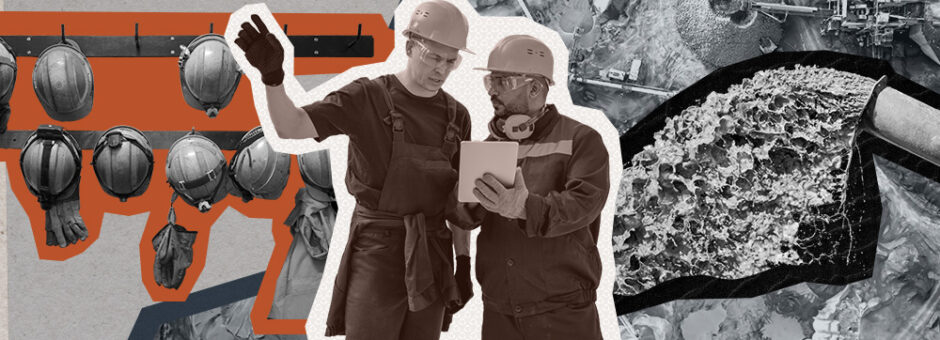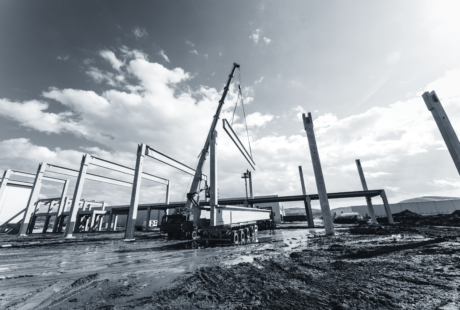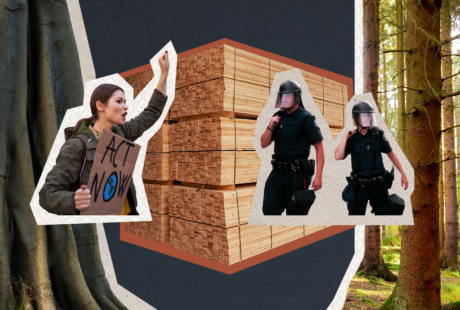The mining industry is currently experiencing shifting demands, rapidly evolving technology, recruiting challenges, and calls for more sustainability. We consulted a panel of industry experts who’ve generously shared their thoughts on these aspects of the industry and more.
Three general themes emerged from our discussions:
- Technological Advancements
- The Need for Sustainability and Sustainable Messaging
- Talent Attraction and Management
| INTERVIEWEES |
| Gheorghe Bonci, Faculty and Academic Program Head BCIT School of Construction and the Environment, Mining Department |
| Mona Forster, Strategic Advisor, Director, and Champion for Natural Resource Development |
| Andrew Clark, Sales Manager, CAC Industrial Ltd. |
IF YOU PREFER, VIEW THE PDF VERSION, OR CONTINUE READING BELOW
Section One – Technology: An Industry in Transition
Embracing New Technology
All of our panelists share an excitement for new technology in the mining industry and sense that this attitude is shared by their colleagues.
“The big players are looking for new types of technologies and that means there is room for innovation. We’re looking at electrification, automation, digitalization, and artificial intelligence. Mechatronics, or robotic technologies, are maybe not for tomorrow but, perhaps, the day after tomorrow. Right now we are facing lower and lower grades of material, so mining management is looking to increase efficiency and productivity, save fuel, lower the operating costs, reduce the waste materials, increase sustainability, including incorporating recycling and reuse into the concept of sustainability and improve the overall safety performance -Gheorghe Bonci
“I think technology has evolved to a point where companies are looking to embrace it. A group that I’m working with right now is in the process of building the world’s first carbon neutral copper mine. There are companies that have created digital representations of their mines, enabling them to monitor the mines in real time.” -Mona Forster
“ITT Goulds has a sensor that attaches to the top of a pump called an i-ALERT. It measures both vibration and temperature and creates a data log so, over a period of time, you will know if a pump continues to run correctly. If the indicator on the i-ALERT is flashing green, then the pump is running within specifications. If the i-ALERT is flashing red, you can consult the app which provides you a reference point to what was happening at the time the sensor went from green to red. Further, we are seeing manufacturers homing in on optimizing their designs using finite element analysis, which allows them to refine things like shaft diameters, casting thickness to name a few. The technology is there and it’s really pushing an old industry into some new technology.” -Andrew Clark
“There are a few companies that have started using AI and machine learning to identify opportunities in historic land areas using old reports and historic information. They’re finding new targets to drill on the exploration side, so it’s creating opportunities there.
Geophysics is also improving. So much of Canada is under cover and the deposits are deeper underground, not obvious at surface. You can’t control where the deposit is, so the easier you can find one, the better.” -Mona Forster
New Approaches in Action
Change has impacted daily business. Andrew Clark, who has written a reference book and app for tech process has embraced a new approach to sales while, in academia, Gheorghe Bonci describes the pivot to online learning.
“We’re not selling used cars, we’re selling mining equipment. We’re working with engineering firms at a very high technical level. We don’t go to the site unless the mine asks us to. It’s more of a consolidative approach, rather than a blind approach where we have a product and half of the little details get missed when it gets to site. It’s not as hard for the client to swallow the sales aspect of it, because we are actually providing a service. We just don’t charge them for hours, we charge the customer for a product.” -Andrew Clark
“We had to switch from face to face teaching to online teaching in just one week last year in March. It wasn’t perfect, but we did it. Some of my colleagues did virtual field trips that went to different interesting areas in order to learn about geology and mining and to answer questions. Sometimes those virtual tours can cover even more information than you can give the students in the real world, but in the real world they have the chance to interact with people working in that environment. At BCIT Mining, we are aware that the pressure on the post-secondary institutions will increase, in an increasingly competitive market, (intense competition for students) in the post-pandemic world. Thus, we acknowledge that the quality of the learning experience will be the most significant differentiator across the board“ -Gheorghe Bonci
Section Two – Sustainability: Changing Practices and Perceptions
New Minerals, New Perceptions
Much has been made about new opportunities for Canada’s mining industry as batteries and other developments drive demand for lithium, copper, cobalt, nickel and other minerals.
“Mining rare elements is an important part of the future Canadian economy and that will drive social licence the industry hasn’t enjoyed for decades.”- Henry Goldbeck, President of Goldbeck Recruiting.
“The industries aren’t that new; people are just putting more spotlight on them, because demand is going to skyrocket as we go forward with electric vehicles and this type of thing. There’s going to be demand for natural resources, for batteries, windings for electric cars, and copper. It’s great for Canada and great for British Columbia.” -Andrew Clark
“The Canadian Government has the critical minerals list where they’ve identified 31 minerals that are important to technology and renewable energy. They have a series of funding programs that you can apply for if you have a new technology. Particularly if you’re moving to carbon neutral or net zero operations, there are opportunities through NRCan and the Canadian Infrastructure Bank. The biggest challenge is having somebody dedicated to working their way through all of the possibilities. If you’re a development company, can you make that transition sooner? It’s a massive undertaking.” -Mona Forster
Sustainable Practices and Messaging
ESG and social licence are topics of major import to the industry. The result is an imperative to evolve practices and to communicate sustainability initiatives effectively.
“Of course the focus is on ESG and the pressure for everybody to become carbon neutral. It’s driving industries towards a place where they’re having to make changes that they weren’t necessarily even contemplating just five years ago.” -Mona Forster
“What we can do is come up with technological improvements in mining and mineral processing, not only to reduce the cost but to improve sustainability.
Right now, the biggest risk the mining industry faces is social licence to operate due to greater scrutiny from customers, stakeholders asking to operate more transparently and uncertainty from the political environment. It’s hard to explain to people that the cell phones they’re using don’t exist without mining.Example: Syncrude has put billions and billions of dollars into mine closure and reclamation. Sometimes they make the site even better than it was before. We need to change the perception that mining is ugly. If you’re looking at the amount of water and land that mining contaminates, it’s a small percentage compared to other industries, e.g.: agriculture, urban development, forestry, or national parks and wilderness areas. Spreading the positive aspects about the mining industry should be a collaborative effort between the mining sector, the private sector, the government, and academia. I think people trust the openness of the mining companies and their positive impact on the community where they operate.” -Gheorghe Bonci
Section Three – Recruiting and Talent Management
A shrinking talent pool coupled with abundant opportunities should make the mining industry an attractive alternative for young people. Attracting talent involves properly communicating the technology and diversity of tasks inherent in today’s mining industry.
Other challenges include promoting good communications and teamwork, as well as attracting a more diverse workforce.
Talent Pool Shrinking
“It’s been a constant challenge, for as long as I’ve been in the industry, to help people understand what we do and how we do it. Mining is so cyclical and we are coming out of yet another downturn. Companies are really struggling to attract talent.” -Mona Forster
“Not a lot of young people were coming into this business. It’s a fantastic business and it’s not going away. We’re looking for technologists and engineers, preferably in mechanical or mining technology.” -Andrew Clark
“There are no problems in other parts of the world, they still have waiting lists with people going into mining programs, which for us is a dream. We had waiting lists back in 2012-15, but now we are struggling to attract people.” -Gheorghe Bonci
Promoting an Exciting, Modern Field
”I think how you sell the mining industry to people is by letting them know that it encompasses all types of mechanical engineering; fluid dynamics, thermal dynamics, machine design. They’re not sitting in a cubical every day doing the same thing.”-Andrew Clark
“The industry associations are critical. I’ve been involved with a group called the Center of Training Excellence for Mining that aims to bring together the mining industry, post secondary education, and government on how to bring and attract people to the sector. It’s about getting people excited about mining because they think that we’re still picks and shovels.
Autonomous vehicles and remote mining are very interesting. As these become more and more common I can see it making the industry more exciting for kids that are in school now. I always thought that, as an industry, we should host some kind of Minecraft competition because Minecraft is about deploying resources to do what you need to do. It seems to me that it’s a natural fit.” -Mona Forster
Structure and Opportunity
“The most important thing that mining executives face right now is the need to understand how future employees might look. Let’s consider digital specialists experts, data experts, data architects, optimization engineers, interface engineers, and chief digital engineers. These are positions that don’t exist in the classic mining company structure. Do you prepare your own employees or hire employees that are ready to go? Are you going to transform mining companies into high-tech companies? In my opinion, the simple and direct answer is no. But we do have to break the traditional company model in order to accommodate. I see new mining companies as super project managers.We are aware that the mining companies will accelerate the implementation of digital technologies, AI, and data analytics for their integrated operations (the mining companies have already adopted and are massively investing in digital capabilities). Thus, we must align our curriculum to the mining sector demands, to understand its staffing requirements, and to try to prepare our students to be ready to deliver the digital capabilities that mining operations require.
Is great for our students to understand the new technologies, but they also need to understand what their work will look like with the companies that adopt these technologies. Because everything will change, from how the mining business is running today with their “classical” roles to the new ones” -Gheorghe Bonci
“If you’re a young engineer in mining, there are huge opportunities for you, because people are retiring. There are massive holes that need to be filled. If you hire the right people, the learning curve is really quick. I’ve met a couple of co-op students that were just extremely brilliant, much smarter than myself. But it’s like any industry, you get a few people that don’t pick it up as quickly or they don’t pick it up at all.” -Andrew Clark
“The technology side is advancing so rapidly but the reality is you still need to have people on the ground.
Heavy duty mechanics are always in big demand. It’s been one of the top trades that we can never seem to have enough of.
I think that the challenge is that, often when people are highly technical and highly focused on their area of expertise, it’s sometimes challenging to understand how all the pieces fit together. It can be difficult to explain to the people that are focused on the technical piece just how important a strong administration and management group is. You can have the greatest project in the world but it won’t matter if you can’t figure out how to get the information out of the work and how to share that information publicly.
Everybody has a superpower, so how do you tap into that? We need people that are good with their hands and those who can think conceptually and in 3D. That’s what’s amazing about the people who are designing these mines; no matter the project, you’re still conceptualizing it inside your mind. That’s a profound talent that not everybody has.” -Mona Forster
The Importance of Diverse Thought
“I think that if you’re only hiring or working with people that think like you or have the same experience as you, then you’re missing out on some opportunities. I’ve seen instances where somebody you might think of as a design professional has an insight, just because they were thinking in a completely different way. I’m a big believer in bringing together subject matter experts and ensuring that teams are connected.
I’ve been involved with women in mining for a long time. I’ve found that the teams I’ve worked on that were more balanced, from an experience and a gender perspective, were more productive. In mining the women are only 16% of the workforce. The focus is always about the leadership level but I believe that, if we have more women in general, the chances of them moving up the ranks are even greater. How do we make mining attractive to women? That’s a whole other conversation.” -Mona Forster
Bright Future
The future of the mining industry poses many questions but our panelists share a sense of optimism and a love for their jobs. It will take this combination of passion and expertise to navigate whatever challenges the future holds for mining in Canada.
“It’ll be interesting to look back ten years from now and see what the industry looks like. We’re enjoying `an increase in metal prices, which makes all of us happy. It means that companies are raising money to be able to advance their projects which means that all the suppliers are getting busy.” -Mona Forster
“I’ve been in this industry for 27 years and it’s awesome. I love it, it’s my life. Once you get into this kind of rotating equipment business, it’s almost impossible to get out of it; it’s just really, really cool. I’m so glad I took this path. Some days I think maybe I should have been a stock broker or something similar, but this industry never has a dull moment. Every day there’s something new. It’s pretty cool.” -Andrew Clark




